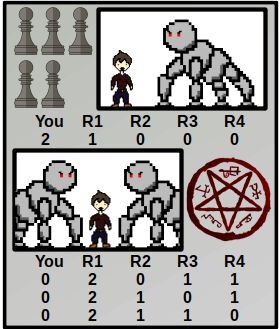The year is 1678, the city of Emil Kraepelin in Germany is living close up an endless horror caused by a group of infernal Wizards. The high council of the city meets every day to decide emergency measures, but Wizards are powerful not only in magic but also in corrupting Counselors behind the welfare of the city.
To understand this game, let’s first address its structure:
- Each player is a city high Counselor;
- The regions of the city are pre-divided according to the number of players;
- There is a deck of secret messages and a deck of monsters;
- In monsters deck cards, we have upper left the number of players (represented by the pawns of chess), and under the figure, how many monsters will attack each region. In the case, YOU refer to your own region in game, while R1, R2, R3 … refers to the first player on your RIGHT, the second player on your RIGHT, the third player on your RIGHT, and so on (because of this, the cards depend on the number of players). Underneath we have an alternative attack option (proposed illegitimately to the Counselor), in some way it can benefit you either by getting rid of monsters in your region or by harming other players. In case, if the player chooses any Wizard option, the player this turn will be corrupted;


- In secret message deck cards, we have upper left the number of players (represented by the pawns of chess), and a official message, which may be a negotiation proposal with the Wizard, an incoming donation, a kingdom benefit or even an irrelevant message. At the bottom of the card, we have an illegitimate proposal, made by the Wizard, it will somehow provide the player with some advantage or benefit, but if the player chooses any Wizard option, the player this turn will be corrupted. Just to emphasize the harmful factor of these agreements for the rest of the city, in the message of the Wizard we also have pawns totaling the number of players minus one, hanged. What it means as this offer despite benefiting the player himself, could harm all others;
- The payout and winnings of these cards are defined as intervals, for example between 30-50, and it is up to the player to choose a value from this range for him. The purpose of this range of values is to confuse other players about situations, and it is not so easy to define whether what the player says they are getting or paying for is really an official message or an illegitimate agreement. Thus providing greater mistrust and stimulating accusations between them. As we will see some rules ahead, being accused in false is an advantage, therefore it harms who has accused you.


- Every turn, each player draws 1 monster card and 1 message card;
- Players will then announce the monsters that have appeared and their respective benefits to receive, even if they are of legitimate or illegitimate origin (in cases where the player has opted for the Wizard’s offer);
- Any player can accuse another of being corrupt soon after this decree his action;
- The accused player must reveal his two last cards to the other players, and if he is corrupt, his newly played moves are undone and corrected;
- Also the corrupt player is marked with an X, forbidden to accuse any other player and if another accusation against him is confirmed, is eliminated from the game;
- If one player accuses another, but the accusation is not confirmed, the accuser receives a /. A second unconfirmed accusation, the accuser receives another \ forming an X, and with an equal penalty to that of the accused and confirmed player, that is, he can not accuse anyone else and if an accusation against him is confirmed, he is eliminated from the game;
If a player with a / receives an accusation, and it is confirmed, the player acquires one more \ forming an X, and with a penalty equivalent to that of the player accused and confirmed;

- The control regions of the Counselors are defined by position cards. Each day, all the players with their own pack of shuffled positions must draw the same number of cards as monsters in their region. The positions that are occupied by monsters remain with their cards out of deck, and when these regions are free of monsters, these position cards return to the deck;
- It is allowed the free negotiation of regions between players during the game, in this case, thus passing the position card referring to the negotiated region;
- There are three types of coins in play, coins of 20, 30 and 100 pieces of gold.
- To put a troop on the field is necessary to pay 80 pieces of gold, the position that the troop occupies is freed of monsters. To move the troop through adjacent houses you must pay 40 pieces of gold per move;
- Each region occupied by a monster at the end of the day does not generate money by collecting taxes. Each region is occupied by a monster at the end of the day, generates 30 pieces of gold as income. At the end of the day all players also receive by the area of largest square corresponding to their monster-free domain regions Area * 10-gold-pieces. For example, at the end of the day, I have a square free zone of monsters corresponding to the 4×4. This generates 16 * 10-gold-pieces, that is, an additional profit of 160 pieces of gold;
- Any player who has until the end of day 4/5 (rounded down) of their dominated regions is automatically removed from the position of Counselor, their money and their possessions are distributed to the remaining players;
- One player’s troops can only advance through another player’s regions, if it allows;
- The game has the following ending conditions:
- If at least two players withstand 10 days of attacks, the remaining players win;
- If only one player remains, the remaining player and the Wizard win;
- If there are no remaining players in the position of Counselors, the Wizard wins.
With these rules we have completed what is necessary to play. It is clear that if only one player remains without the X mark, he can accept all the offers of the Wizard without fear of being denounced, and as a consequence, harm all other players. This issue of trust and betrayal is the essence of Corruption Game.


